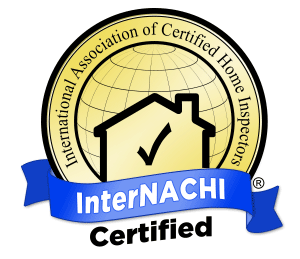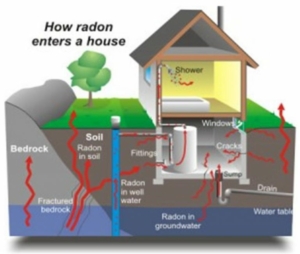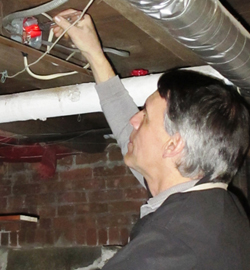Radon Gas Testing
There are cracks in the foundation. Nothing structural. Nothing thats going to threaten the stability of the home, but they are there. Nooks, crannies and holes through which seeps an invisible threat. Colorless, odorless and undetectable by your average human, it is none the less the second leading cause of lung cancer in the United States.
Radon Gas Testing – even the name sounds ominous, is created when uranium in the soil decays. The gas then seeps through any access point into a home. Common entry points are cracks in the foundation, poorly sealed pipes, drainage or any other loose point. Once in the home, the gas can collect in certain areas especially basements and other low-lying, closed areas and build up over time to dangerous levels. The Environmental Protection Agency of the US Government has set a threshold of 4 pico curies per liter as the safe level. As humans are exposed to the gas over a period of years, it can have a significant and detrimental effect.
How widespread is the problem? Radon has been found in homes in all 50 states. Certain areas are more susceptible than others (http://www.epa.gov/radon/), but no location is immune. Concentrations of radon-causing materials in the soil can be either natural or man-made. Homes built near historic mining operations may be at higher risk. The only way to tell for sure is to have a home tested.
Testing for radon comes in two forms: active and passive. Active devices constantly measure the levels of radon in a portion of the home and display those results. Passive devices collect samples over a period of time and then are taken away and analyzed. Either method can help you determine your level of risk.
At Home and Hearth Inspections, Inc. we are qualified to perform Radon tests for you as we have received certification through National Environmental Health Association (www.NEHA.org). This training is essential for proper Radon testing. Without proper testing it is not possible to receive accurate results.
We can perform a passive test or an active test. The passive method uses two activated charcoal canisters placed in the lowest livable area of your house. The canisters are left for a minimum of 48 hours to a maximum of 96 hours. They are then mailed to a lab and the results sent to you by e-mail directly from the lab. The active method uses very sophisticated calibrated electonic devices equipped with numerous sensors to detect tampering. If you choose this method, you get your results immediately once your home inspector retrieves the machine. If you can’t be there, we will e-mail the results to you that evening.
If high concentrations of radon are found in your home, you have several options. Since radon is only a problem when it is concentrated in high volume, improving the ventilation in an area is often sufficient to solve the problem. In other cases, it may be necessary to limit the amount of radon getting into the home by sealing or otherwise obstructing the access points. Once again, a professional should be engaged to ensure that the radon is effectively blocked. Typical radon mitigation systems can cost between $800 and $2500, according to the EPA.
If you’re buying or selling a home, radon can be a significant issue. Buyers should be aware of the radon risk in their area and determine whether a radon test is desirable. When in doubt, the EPA always recommends testing. The cost of the test can be built into the house price. If test results already exist, make sure they are recent or that the home has not been significantly renovated since the test was performed. If in doubt, get a new test done. If you’re selling a home, having a recent radon test is a great idea. By being proactive, you can assure potential buyers that there is no risk and avoid the issue from the start.
So whether you have an old home or a new one Radon Gas Testing in Brockton, MA. is a reality. But it is a reality that we can live with. Proper testing and mitigation, can eliminate radon as a health threat. For more information, visit the EPA web site on radon at http://www.epa.gov/radon/.
Massachusetts also has good information on Radon. Go to the following website http://www.mass.gov/eohhs/gov/departments/dph/programs/environmental-health/exposure-topics/radiation/radon/public-health-fact-sheet-on-radon.html for the PUBLIC HEALTH FACT SHEET – RADON.
Inspector Profiles
Inspection Services
Do You Have a Question?
Do you have a question relating to home inspections ? We can help. Simply fill out the form below and we’ll contact you with the answer, with no obligation to you. We guarantee your privacy.
MEMBERSHIPS & CERTIFICATIONS

As a member of the International Association of Certified Home Inspectors, we adhere to a strict code of ethics as a home inspector. The code of ethics can be viewed here: International Association of Certified Home Inspectors (InterNACHI) website.




Radon Gas Testing
/0 Comments/in Inspection Services /by pippindesignRadon Gas is created when uranium in the soil decays. The gas then seeps through any access point into a home.
Water Quality Testing & Well Yield Testing
/0 Comments/in Inspection Services /by pippindesignTesting your drinking water for the presence of organic and inorganic chemicals.
Inspections for Wood Destroying Insects
/0 Comments/in Inspection Services /by pippindesignTermites and other wood destroying insects such as carpenter ants can do massive damage to a home.
Pre-Sale Inspections for Sellers
/0 Comments/in Inspection Services /by pippindesignIf you are selling a home, you’ll get the highest price in the shortest time, if your home is in top condition.
Home and Condo Inspections
/0 Comments/in Inspection Services /by pippindesignThe inspection report will tell you what needs to be repaired and what routine maintenance tasks you should perform to keep the house in top condition.
Multi-family Home Inspections
/0 Comments/in Inspection Services /by pippindesignThere are good reasons to have a professional inspection performed on the new home or investment property you are buying. Buying a new house is likely the largest purchase decision you’ll ever make. The whole process is fraught with emotion and stress.